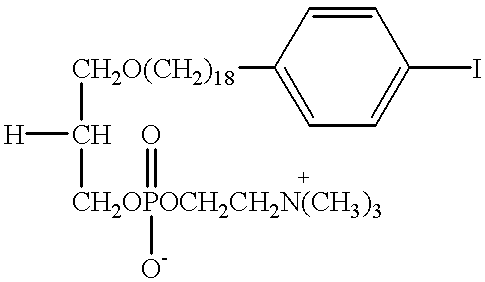Radioiodinated phospholipid ether analogs and methods of using the same
a technology of phospholipid ether and radioiodinated phospholipid, which is applied in the field of radioiodinated phospholipid ether analogs and methods of using the same, can solve the problems of tissue-destructive radiopharmaceuticals by more than one, and achieve the effects of reducing accumulation, improving tumor imaging capabilities, and increasing plasma half-li
- Summary
- Abstract
- Description
- Claims
- Application Information
AI Technical Summary
Benefits of technology
Problems solved by technology
Method used
Image
Examples
example 2
Further conversion of 18-(p-iodophenyl) octadecanol into the desired phosphocholines was performed as described in detail for the C-12 analogs in Rampy et al., "Synthesis and biological evaluation of radio-iodinated phospholipid ether analogs," Nucl. Med. Biol. 22, 505-512 (1995). In one preferred embodiment, the improved phospholipid ether analog contemplated by the present invention is a simple straight chain alkyl phospholipid, 18-(p-iodophenyl)octadecyl phosphocholine (Compound XVI). The synthesis of Compound XVI was accomplished according to the illustrative preparatory scheme shown in FIG. 2.
As illustrated in FIG. 2, 2-chloro-2-oxo-1,3,2-dioxaphospholane (0.025 ml; 0.27 mmol) was added to the stirred solution of 18-(p-iodophenyl)octadecanol (Compound VI) (115 mg; 0.24 mmol) in dry benzene (3 ml) containing triethylamine (0.042 ml; 0.29 mmol). Stirring was continued overnight. The precipitated triethylamine hydrochloride was filtered off and the solvent was removed in vacuo. Th...
example 3
In another preferred embodiment, the improved phospholipid ether analogs contemplated by the present invention are constructed using a propanediol backbone. In this example, the synthesis of 1-O-[18-(p-Iodophenyl)octadecyl]-1,3-propanediol-3-phosphocholine (Compound XIV) was accomplished according to the illustrative preparatory scheme shown in FIG. 3.
To a solution of 18-(p-iodophenyl)octadecanol (Compound VI) (150 mg; 0.317 mmol) and triethylamine (0.07 ml; 0.475 mmol) in dry methylene chloride (2 ml) was added methane sulfonyl chloride (0.03 ml; 0.38 mmol) at 0.degree. C. Stirring was continued for 40 min and the reaction was quenched by addition of water. The reaction mixture was diluted with chloroform and washed several times with water. The chloroform layer was dried (Na.sub.2 SO.sub.4) and evaporated. The residue was chromatographed in hexane-ethyl acetate (9:1). This afforded pure Compound VII, 18-(p-Iodophenyl)octadecyl methanesulfonate (142 mg; 82% yield).
To a solution of ...
example 4
This example illustrates yet another preferred embodiment of the improved phospholipid ether analogs contemplated by the present invention, wherein the hydrogen located at the 2-position of Compound XIV is replaced with an O-methyl group. The synthesis of 1-O-[18-(p-Iodophenyl)octadecyl]-2-O-methyl-rac-glycero-3-phosphocholine (Compound XV) was accomplished according to the illustrative preparatory scheme shown in FIG. 4.
Compound XI, 1-O-[18-(p-Iodophenyl)octadecyl]-2-O-methyl-3-O-benzyl-rac-glycerol, was synthesized as described above in Example 3 above for Compound X, from 18-(p-iodophenyl) octadecyl methanesulfonate (Compound VII) (67 mg) and 1-O-benzyl-2-O-methyl-rac-glycerol (Compound IX) (36 mg), (62 mg, 78% yield). The synthesis of Compound IX is known in the art and is described in detail in Pinchuk et al., Chem. Phys. Lipids. 59:263-65 (1991). Briefly, to 2-O-methyl-1,2-O,O-benzylideneglycerol (2.4 g, 12.4 mmol) cooled in an ice bath was added 18 ml of 1.0 M borane-THF solu...
PUM
| Property | Measurement | Unit |
|---|---|---|
| temperature | aaaaa | aaaaa |
| temperature | aaaaa | aaaaa |
| temperature | aaaaa | aaaaa |
Abstract
Description
Claims
Application Information
 Login to View More
Login to View More - R&D
- Intellectual Property
- Life Sciences
- Materials
- Tech Scout
- Unparalleled Data Quality
- Higher Quality Content
- 60% Fewer Hallucinations
Browse by: Latest US Patents, China's latest patents, Technical Efficacy Thesaurus, Application Domain, Technology Topic, Popular Technical Reports.
© 2025 PatSnap. All rights reserved.Legal|Privacy policy|Modern Slavery Act Transparency Statement|Sitemap|About US| Contact US: help@patsnap.com



